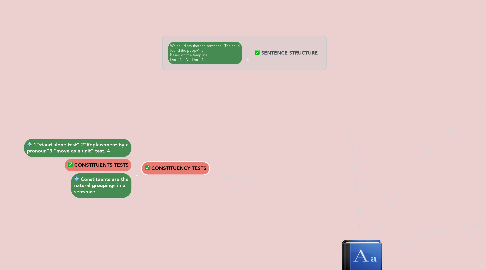
1. A syntactic category is a family of expressions that can substitute for one another without loss of grammaticality.
2. • A tree diagram is a way of representing the hierarchical nature of a structure in a graphical form. It is named a "tree diagram” because the classic representation resembles a tree, even though the chart is generally upside down compared to an actual tree, with the "root" at the top and the "leaves" at the bottom. • Tree diagram provides us visual representation of the constituents of the corresponding expression.
3. SENTENCE STRUCTURE
3.1. We could say that the sentence “The child found the puppy” is based on the template Det—N—V—Det—N
4. CONSTITUENCY TESTS
4.1. 1“stand alone test” 2“Replacement by a pronoun”3.“move as a unit” test. 4
4.2. CONSTITUENTS TESTS
4.3. Constituents are the natural groupings in a sentence.
5. SYNTACTIC CATEGORY
5.1. Phrasal categories
5.2. NP, VP, PP, AP, AdvP
5.3. Lexical categories
5.3.1. • Noun: happiness, pillow. • Verb: find, run, sleep, realize, see, want • Preposition: up, down. • Adjective: red, big, candid, lucky, large • Adverb: again, carefully, luckily, very.
5.4. Functional categories
5.5. •Auxiliary: verbs such as have, and be, and modals such as may, can, will, shall, must. • Determiners: the, a, this, that, those, each, every.
6. TREE DIAGRAM.
6.1. PHRASE STRUCTURE TREES AND RULES
6.1.1. Phrase structure rules specify the well-formed structures of a sentence A tree must match the phrase structure rules to be grammatical This tree is formed using the following rules: S NP VP NP ---- Det N VP ---- V NP
6.1.2. -Phrase structure rules are used as a guide for building trees -To build a tree you expand every phrasal category until only the lexical categories remain -By following the guidelines in the phrase structure rules, we can generate all the possible grammatical sentences in a language
7. RULES
7.1. The rules of syntax combine words into phrases and phrases into sentences.
7.2. They also specify the correct word order for a language.
7.3. They also describe the relationship between the meaning of a group of words and the arrangement of the words.
7.4. The rules of syntax also specify the grammatical relations of a sentence, such as the subject and the direct object. “Who is doing what to whom”
7.5. Syntax rules specify constraints (limitations or restrictions on sentences based on the verb of the sentence.
7.6. Syntax rules also tell us how words form groups and are hierarchically ordered in a sentence.
8. GENERATIVE GRAMMAR
8.1. This grammar attempts to produce all and only grammatical sentences of language..
8.1.1. Generative Grammar is a set of formal rules used to generate or define the membership of an infinite set of grammatical sentences in a language.
8.2. DEEP AND SURFACE STRUCTURE. An abstract level of structural organization in which all the elements determining structural interpretation are represented.
8.2.1. SYNTAX ESTRUCTURE.
8.2.2. The generative grammar defines the syntactic structures of a language.
8.3. STRUCTURAL AMBIGUITY. Distinct underlying interpretations that have to be represented differently in deep structure.
8.3.1. The grammar will generate all the well formed syntactic structures.
8.3.2. For a sentence to be well-formed, it must conform to the structural constraints of PS rules and must also obey the syntactic (C-selection) and semantic (S-selection) requirements of the head of each phrase.
8.3.3. The grammar will have a finite number of rules but will generate infinite number of well formed structures.
9. THE INFINITY OF LANGUAGE: RECURSIVE RULES
9.1. Recursive rules are rules in which a phrasal category can contain itself.
9.2. HEADS AND COMPLEMENTS
9.2.1. The head of a phrase names the phrase (e.g. the noun is the head of a noun phrase, a verb is the head of a verb phrase, etc.)
9.2.2. • C-selection or subcategorization refers to the information about what types of complements a head can or must take.
9.2.3. STRUCTURAL AMBIGUITIES
9.2.3.1. The following sentence has two meanings: The boy saw the man with the telescope • The meanings are: • 1. The boy used the telescope to see the man • 2. The boy saw the man who had a telescope • Each of these meanings can be represented by a different phrase structure tree • The two interpretations are possible because the PS rules allow more than one structure for the same string of word.
9.2.3.2. OTHER STRUCTURE. 1. S--------NP/VP
9.2.3.3. 2. NP....DET./N
9.2.3.4. 3. DET-----NP/POSSS ('S)
9.2.3.5. 4.NP------N
9.2.3.6. 5. NP----NP/PP
9.2.3.7. 6- N-----ADJ/N
9.2.3.8. 7. N......N
9.2.3.9. 8- VP.....V 9. VP----V/NP 10. VP----V/CP 11. VP---AUX/VP 12. VP---VP/PP
9.2.3.10. 13. PP...P/NP 14. CP...CS
9.2.3.10.1. CREATED BY NELSON
